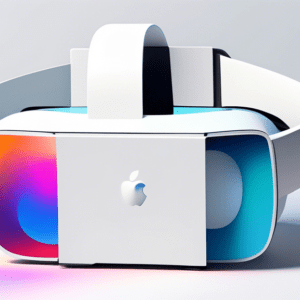Apple’s Rumored Budget VR/AR Headset: What We Know So Far
Apple’s foray into the world of virtual and augmented reality has been highly anticipated. While the initial unveiling of the Apple Vision Pro showcased a premium device with cutting-edge technology and a hefty price tag, recent rumors suggest a more affordable headset is on the horizon. Speculation is rife that this budget-friendly version will feature larger, lower-resolution displays, potentially impacting both the visual experience and the headset’s overall design.
A Strategic Move for Wider Adoption?
The rumored shift towards larger, lower-resolution displays for Apple’s budget headset could be a strategic move to achieve a more accessible price point. High-resolution displays, especially those with the advanced micro-OLED technology used in the Vision Pro, are a significant contributor to the device’s cost. By opting for larger displays with a lower pixel density, Apple could potentially reduce manufacturing costs without drastically compromising the field of view.
However, this design choice comes with trade-offs. Lower resolution displays could result in a less immersive and potentially pixelated VR experience, especially when users are close to virtual objects or text. The screen-door effect, where the spaces between pixels become noticeable, could be more apparent. This trade-off between affordability and visual fidelity might be a gamble for Apple, as the success of VR and AR hinges significantly on delivering compelling and immersive experiences.
Design Implications and Potential Advantages
The use of larger displays could necessitate a bulkier design for the budget headset. Larger displays require more physical space, potentially leading to a heavier and less compact device. This could impact user comfort during extended wear, a crucial factor for VR and AR adoption.
However, there’s a potential silver lining. Larger displays might translate to a wider field of view, offering a more expansive and immersive visual experience. A wider field of view can reduce the sensation of looking through binoculars and create a greater sense of presence within virtual environments. This could be a significant advantage, particularly for gaming and entertainment applications.
Balancing Cost and User Experience
The success of Apple’s rumored budget VR/AR headset hinges on striking a delicate balance between affordability and user experience. While cost is a major barrier to entry for VR and AR, compromising too heavily on the visual experience could deter potential adopters.
Apple will need to leverage its renowned design prowess and software ecosystem to compensate for any potential shortcomings of lower-resolution displays. This could involve innovative software features that enhance visual fidelity, optimize content for the specific display technology, or create experiences that minimize the impact of lower resolution.
Competing in the VR/AR Landscape
The VR and AR market is becoming increasingly competitive, with established players like Meta and emerging companies vying for market share. Apple’s entry into the budget-friendly segment could disrupt the landscape, potentially attracting a wider audience with a more accessible price point.
However, Apple will need to carefully position its budget headset against the competition. Devices like the Meta Quest 2 already offer a compelling combination of affordability and performance. Apple’s success will depend on its ability to differentiate its offering, potentially through a tighter integration with its existing ecosystem, a focus on user privacy, or unique software experiences.
Looking Ahead: The Future of Apple’s VR/AR Ambitions
The rumored budget VR/AR headset could be a stepping stone in Apple’s broader strategy for augmented and virtual reality. By offering a more affordable entry point, Apple could attract a larger user base and foster the development of a thriving AR/VR ecosystem.
This could pave the way for the adoption of more advanced and expensive headsets like the Vision Pro, positioning Apple as a leader in the evolving landscape of spatial computing. The success of this strategy will depend on several factors, including the final specifications and pricing of the budget headset, the quality of the software experiences, and Apple’s ability to effectively market its vision for the future of AR and VR.
The Potential of Apple’s Ecosystem
One of Apple’s greatest strengths lies in its tightly integrated ecosystem. The company has a proven track record of seamlessly connecting its devices and services, creating a user-friendly and compelling experience. This ecosystem could be a significant advantage for Apple’s VR/AR ambitions, even with a budget-friendly headset.
Imagine a scenario where the headset seamlessly interacts with your iPhone, iPad, and Mac, allowing you to transition between virtual and real-world tasks with ease. Educational content consumed on an iPad could be transformed into interactive 3D experiences within the headset. Games played on an iPhone could be enhanced with augmented reality features when viewed through the headset’s cameras. The possibilities are vast.
Addressing Concerns: Privacy and Content
Apple has consistently emphasized user privacy as a core value. This focus on privacy could be a significant differentiator in the VR/AR space, especially given the immersive nature of these technologies. Apple’s commitment to data security and user control could resonate with privacy-conscious consumers.
Another crucial factor for the success of Apple’s VR/AR endeavors will be the availability of compelling content. The company’s existing relationships with developers and its App Store ecosystem give it a strong starting point. However, Apple will need to actively encourage the development of high-quality VR and AR experiences that showcase the capabilities of its headsets. This could involve creating dedicated development tools, fostering partnerships with content creators, and potentially even funding original VR/AR content.
Conclusion: A Waiting Game
As of now, details about Apple’s budget VR/AR headset remain shrouded in speculation. However, the possibility of a more affordable device entering the market is an exciting prospect for both consumers and the VR/AR industry as a whole. If Apple can successfully navigate the challenges of balancing cost, design, and user experience, it could have a significant impact on the adoption and evolution of these immersive technologies. The coming months and years will be telling as we witness how Apple’s VR/AR vision unfolds.
